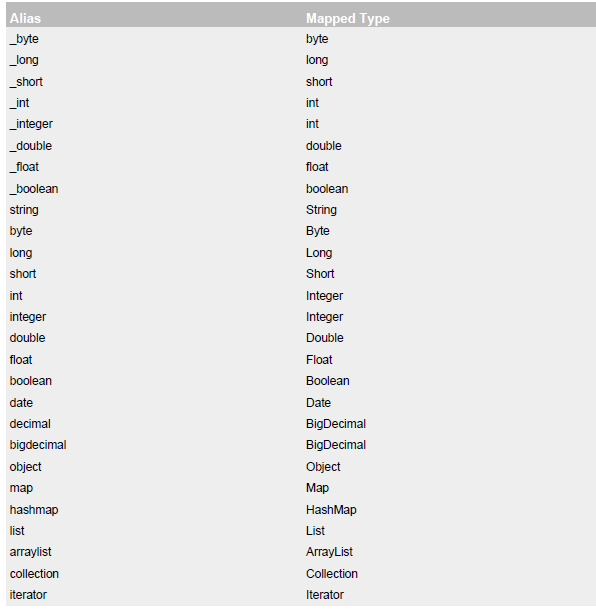这篇文章将为大家详细讲解有关collection与association在Mybatis中有什么区别,文章内容质量较高,因此小编分享给大家做个参考,希望大家阅读完这篇文章后对相关知识有一定的了解。
1. 关联-association
2. 集合-collection
比如同时有User.java和Card.java两个类
User.java如下:
public class User{ private Card card_one; private List<Card> card_many; }在映射card_one属性时用association标签, 映射card_many时用collection标签.
所以association是用于一对一和多对一,而collection是用于一对多的关系
下面就用一些例子解释下吧
association-一对一
人和身份证的关系
下面是pojo
public class Card implements Serializable{ private Integer id; private String code; //省略set和get方法. }public class Person implements Serializable{ private Integer id; private String name; private String sex; private Integer age; //人和身份证是一对一的关系 private Card card; //省略set/get方法. }下面是mapper和实现的接口
package com.glj.mapper; import com.glj.poji.Card; public interface CardMapper { Card selectCardById(Integer id); }<?xml version="1.0" encoding="UTF-8"?> <!DOCTYPE mapper PUBLIC "-//mybatis.org//DTD Mapper 3.0//EN" "http://mybatis.org/dtd/mybatis-3-mapper.dtd"> <mapper namespace="com.glj.mapper.CardMapper"> <select id="selectCardById" parameterType="int" resultType="com.glj.poji.Card"> select * from tb_card where id = #{id} </select> </mapper>package com.glj.mapper; import com.glj.poji.Person; public interface PersonMapper { Person selectPersonById(Integer id); }<?xml version="1.0" encoding="UTF-8"?> <!DOCTYPE mapper PUBLIC "-//mybatis.org//DTD Mapper 3.0//EN" "http://mybatis.org/dtd/mybatis-3-mapper.dtd"> <mapper namespace="com.glj.mapper.PersonMapper"> <resultMap type="com.glj.poji.Person" id="personMapper"> <id property="id" column="id"/> <result property="name" column="name"/> <result property="sex" column="sex"/> <result property="age" column="age"/> <association property="card" column="card_id" select="com.glj.mapper.CardMapper.selectCardById" javaType="com.glj.poji.Card"> </association> </resultMap> <select id="selectPersonById" parameterType="int" resultMap="personMapper"> select * from tb_person where id = #{id} </select> </mapper>PersonMapper.xml 还使用association的分步查询。
同理多对一,也是一样
只要那个pojo出现private Card card_one;
即使用association
collection 一对多和association的多对一关系
学生和班级的一对多的例子
pojo类
package com.glj.pojo; import java.io.Serializable; import java.util.List; public class Clazz implements Serializable{ private Integer id; private String code; private String name; //班级与学生是一对多的关系 private List<Student> students; //省略set/get方法 }package com.glj.pojo; import java.io.Serializable; public class Student implements Serializable { private Integer id; private String name; private String sex; private Integer age; //学生与班级是多对一的关系 private Clazz clazz; //省略set/get方法 }<?xml version="1.0" encoding="UTF-8"?> <!DOCTYPE mapper PUBLIC "-//mybatis.org//DTD Mapper 3.0//EN" "http://mybatis.org/dtd/mybatis-3-mapper.dtd"> <mapper namespace="com.glj.mapper.ClazzMapper"> <select id="selectClazzById" parameterType="int" resultMap="clazzResultMap"> select * from tb_clazz where id = #{id} </select> <resultMap type="com.glj.pojo.Clazz" id="clazzResultMap"> <id property="id" column="id"/> <result property="code" column="code"/> <result property="name" column="name"/> <!-- property: 指的是集合属性的值, ofType:指的是集合中元素的类型 --> <collection property="students" ofType="com.glj.pojo.Student" column="id" javaType="ArrayList" fetchType="lazy" select="com.glj.mapper.StudentMapper.selectStudentByClazzId"> <id property="id" column="id"/> <result property="name" column="name"/> <result property="sex" column="sex"/> <result property="age" column="age"/> </collection> </resultMap> </mapper>package com.glj.mapper; import com.glj.pojo.Clazz; public interface ClazzMapper { Clazz selectClazzById(Integer id); }ClazzMapper使用到了集合-collection 即为一对多,一个班级面对多个学生
<?xml version="1.0" encoding="UTF-8"?> <!DOCTYPE mapper PUBLIC "-//mybatis.org//DTD Mapper 3.0//EN" "http://mybatis.org/dtd/mybatis-3-mapper.dtd"> <mapper namespace="com.glj.mapper.StudentMapper"> <select id="selectStudentById" parameterType="int" resultMap="studentResultMap"> select * from tb_clazz c,tb_student s where c.id = s.id and s.id = #{id} </select> <select id="selectStudentByClazzId" parameterType="int" resultMap="studentResultMap"> select * from tb_student where clazz_id = #{id} </select> <resultMap type="com.glj.pojo.Student" id="studentResultMap"> <id property="id" column="id"/> <result property="name" column="name"/> <result property="sex" column="sex"/> <result property="age" column="age"/> <association property="clazz" javaType="com.glj.pojo.Clazz"> <id property="id" column="id"/> <result property="code" column="code"/> <result property="name" column="name"/> </association> </resultMap> </mapper>package com.glj.mapper; import com.glj.pojo.Student; public interface StudentMapper { Student selectStudentById(Integer id); }StudentMapper则是与班级为多对一关系,所以使用了关联-association
嗯,希望我以后又不记得二者的关系时,能感谢现在总结的自己
附上一张mybatis的类型别名图

关于collection与association在Mybatis中有什么区别就分享到这里了,希望以上内容可以对大家有一定的帮助,可以学到更多知识。如果觉得文章不错,可以把它分享出去让更多的人看到。
免责声明:本站发布的内容(图片、视频和文字)以原创、转载和分享为主,文章观点不代表本网站立场,如果涉及侵权请联系站长邮箱:is@yisu.com进行举报,并提供相关证据,一经查实,将立刻删除涉嫌侵权内容。